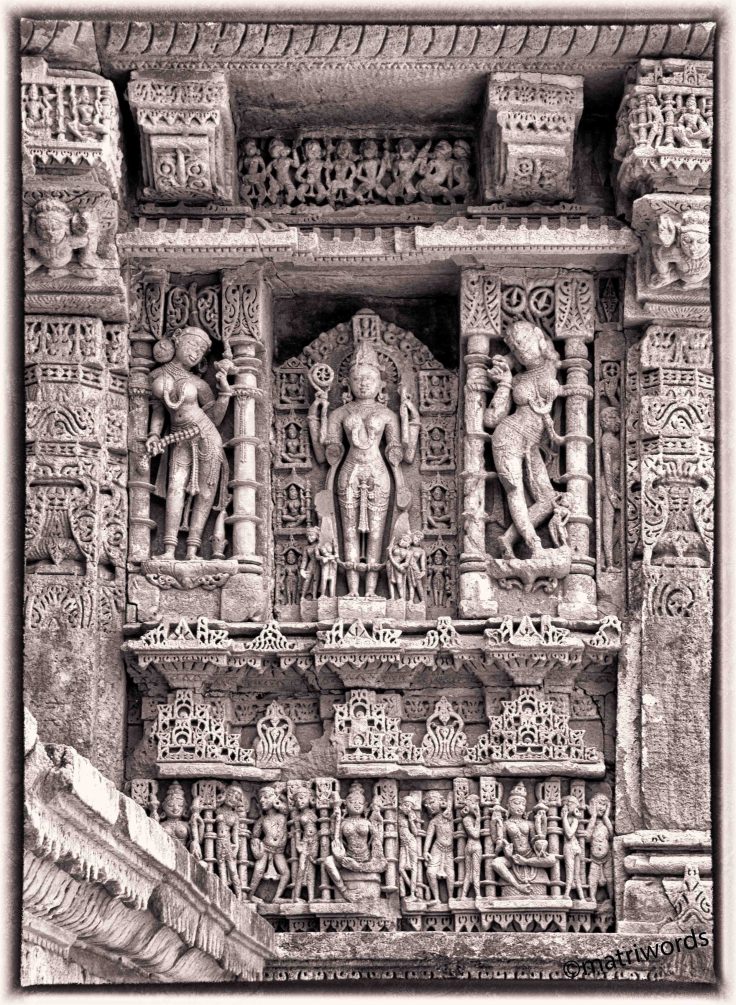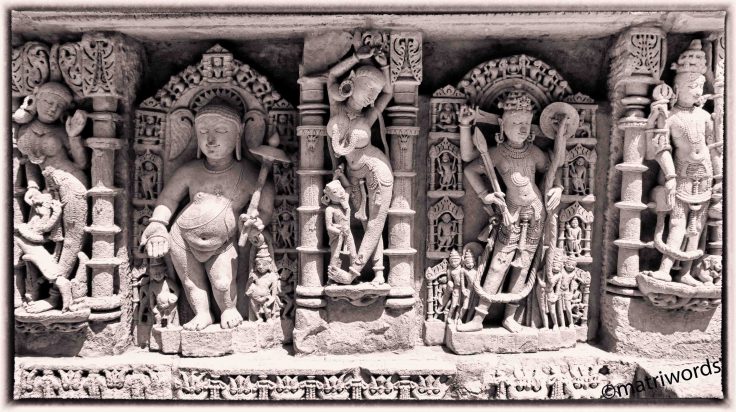She was hiding herself rather well.
Hidden from the onlookers’ glances, from the evil eye of those who would have destroyed her sanctity and pristine charm, she waited patiently for the time when she could reveal herself. Waited for several centuries. Thus goes the story of the queen we shall meet today.
She truly is a queen, most gorgeously amazing among the amazing stepwells of India.
Rani ni Vav – the Queen’s Stepwell

In the Vedic literature water is regarded as the first important element that gave rise to the subsequent evolution of the universe. Seen as an embodiment of self-awareness and higher mental clarity, water is referred to as a source of life, protector of earth and environment, nectar, honey, generator of prosperity, cleanser of sins and so on.
Guided by the deeper view of the divinity and sacredness of Mother Earth, and particularly water as a life-giving element, it is not surprising to discover that our ancestors had made great advancement in almost all domains of water management.

Distinctive form of subterranean water resource and storage systems, often highly decorated architectural structures, stepwells trace their origins to about 7th century CE in the semi-arid regions of Gujarat and Rajasthan. From about 900 to 1300 CE they became elaborate water buildings, deeply invested with ritual and social-cultural meanings.
Earliest clear evidence of the origins of the stepwell is found in archaeological site at Mohenjodaro (in present-day Pakistan). Rock-cut stepwells in the subcontinent date from 200 to 400 CE.

One of the most exquisite and ornate stepwells, Rani ni Vav is located near the small town of Patan in Gujarat. It was built as a memorial to an 11th century king Bhimdev I by his queen Udayamati.
Built in the complex Maru-Gurjara architectural style with an inverted temple and seven levels of stairs, Rani ni Vav holds more than 500 principal sculptures.
At some point the stepwell was flooded by the nearby Saraswati River and silted over, hidden and almost forgotten. It was only in late 1980s when the Archaeological Survey of India conducted excavations at the site, the queen revealed herself. And the world came to see the exquisite carvings and sculptures on the walls of this stepwell, most of which were found in pristine condition.
It is the minute and exquisite carving of Rani-Ki-Vav which gives it the title of the queen among stepwells of India. Rani ni Vav was added to the list of UNESCO’s World Heritage Sites in 2014.

Most of the sculptures we see on the ornately carved walls of this vav are dedicated to Lord Vishnu, in the forms of Dasavatara (Ten Avataras). There are also several carvings of Apsaras, Yoginis, Nagkanya, and other celestial beings. It was believed that the deities surrounding the stepwell protected the sanctity and healing properties of the water.


It is believed that as recently as 50 to 60 years back the area around Rani ni Vav was surrounded by many medicinal plants used in Ayurveda. This gave the water accumulated in the stepwell healing properties.
“European critics complain that in her ancient architecture, sculpture and art there is no reticence, no holding back of riches, no blank spaces, that she labours to fill every rift with ore, occupy every inch with plenty. Well, but defect or no, that is the necessity of her superabundance of life, of the teeming of the infinite within her. She lavishes her riches because she must, as the Infinite fills every inch of space with the stirring of life and energy because it is the Infinite.” (Sri Aurobindo, CWSA, Vol. 20, p. 8)


Even in the least thing & the most ordinary event, India saw a potential for beauty, beauty which could act as a vehicle for the Divine 🙏
LikeLiked by 1 person
Indeed! And what an unfortunate turn of events that over the last several centuries we have been forgetting the deeper truth behind Beauty as a Way to the Divine. With Mother’s Grace that sensibility will also be recovered as Indian spirit comes more and more to the forefront in all the domains of our activities.
Thanks for sharing your thought, Mohit! Good to see you here on the blog 🙂
LikeLike
Hope the recovery is swift and thorough…Really beautiful post Di.. Please keep doing the Divine’s work 🙂
LikeLiked by 1 person
Praying for Her Guidance! 🙂
LikeLike
So glad to read your post after a long time. The sculptures are beautiful. .. So intricately designed. I didn’t even know about this place. Which makes me wonder on how much of these beautiful historical places remain unknown to many.
LikeLiked by 1 person
Happy to know that you enjoyed the post, Rajlakshmi. Yes, isn’t it strange that such treasures of our heritage are not much talked about in our popular cultural discourse?! Our tourism departments have big task cut out for them 🙂
LikeLike
Wow, it is truly an exquisite site. I have only heard that Gujrat has many such treasures. Beautiful clicks, Beloo. I really enjoy these photo features 🙂
LikeLiked by 1 person
Thanks Inderpreet! This stepwell is indeed a marvel, one has to see it to believe it. Hope you get an opportunity to visit this place sometime!
LikeLike
Amazing pics. So many wonderful heritage sites exist which have such an amazing history associated with them but they just do not get their due…
Godyears.net
LikeLiked by 1 person
Thanks, Roshan! Yes, somehow we have never bothered to learn (nor have we been told) about these amazing places in our country. We, and our tourism departments, have been blissfully (as in ignorantly) content with the colonizer’s gaze exclusively on certain places of repute. O well…glad things are beginning to be stirred up at least, even though it will take a long, long time before we Indians learn to take genuinely healthy pride in all that our ancestors have left for us, regardless of the antiquity.
LikeLike